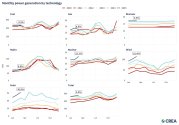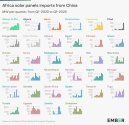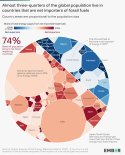You are using an out of date browser. It may not display this or other websites correctly.
You should upgrade or use an alternative browser.
You should upgrade or use an alternative browser.
Climate Change and Renewable Energy News and Discussion
- Thread starter FairAndUnbiased
- Start date
supercat
Colonel
Newly installed wind and solar power overtook newly installed thermal power for the first time in China at the end of March.
China contributed almost 64% of the global added capacity of renewable energy last year.
China contributed almost 64% of the global added capacity of renewable energy last year.
In addition, progress yet again reflects significant geographic disparities. As in previous years, most of the increase occurred in Asia, with the greatest share being contributed by China – almost 64% of the global added capacity – while Central America and the Caribbean contributed the least at only 3.2%. The G7 and G20 countries respectively accounted for 14.3% and 90.3% of new capacity in 2024.
Apparently, 10 new nuclear reactors were approved.
Chinese clean tech exports to emerging markets were up significantly in 2024, and are expected to rise further this year.
This comes despite a slight slump in the overall market, with the Chinese share of new investments exceeding 75%.
accounted for 43 per cent of Chinese clean tech exports in 2024, up from 24 per cent in 2022, in a sign of how the manufacturing powerhouse is seeking out new markets, according to new figures from BloombergNEF, the data provider. Falling prices at the same time made the green energy products more affordable in developing countries.
’s focus on exports to emerging markets would intensify on the back of “extreme levels of tariffs” from the US — now standing at 145 per cent for Chinese goods — as well as growing trade barriers from the EU and elsewhere, said Antoine Vagneur-Jones, head of trade and supply chains at BNEF. “We don’t think that we’ve reached anywhere the levels of penetration, the volumes of exports [to emerging markets] that we could be seeing,” he added.
This comes despite a slight slump in the overall market, with the Chinese share of new investments exceeding 75%.
Last year, the value of global clean energy imports shrank for the first time, down 7 per cent to $409bn, mainly driven by falling prices for solar and battery technology, BNEF said. Vagneur-Jones said this fall in value was despite overall volumes remaining steady or rising for various technologies. BNEF found that more than three-quarters of all new investments globally into green tech manufacturing was in China last year.
supercat
Colonel
China was the world's largest producer and consumer of hydrogen power in 2024. China was also the largest producer of hydrogen using renewable energy in the same year, contributing more than 50% of global total.
A paper on the quantitative reductions in carbon intensity as a product of spatial spillovers from better tech.
This study investigates the impact of technological innovation on the carbon intensity of Chinese cities using a spatial Durbin model combined with prefecture-level data. Through a standard spatial econometric analysis, this paper reveals the spatial relationship between the innovation and carbon emission, which exceeds the maximum explanatory power of linear regression. The results of empirical analysis show that:
(1) overall, the improvement of technological innovation level in China has a negative spatial spillover effect on the carbon emission intensity of cities, which can reduce the carbon emission intensity of the city and the neighboring cities;
(2) from a geographical perspective, the spatial spillover effect of the level of technological innovation on the carbon emission intensity of cities in western China is not significant compared with cities in other regions;
(3) the spatial spillover effect of the improvement of technological innovation on the carbon emission intensity of non-resource-based cities is more significant than that of resource-based cities. Therefore, we need to increase investment in technological innovation and optimize the industrial structure. At the same time, we need to fully utilize the spatial spillover effect to help cities achieve synergistic carbon reduction.



